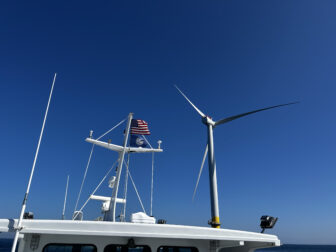Politico Magazine
By Bill Mckibben and Mike Tidwell
If you want to know just how bad an idea it is for America to ship “fracked” natural gas to overseas markets, travel the 65 miles from the White House to a place called Cove Point in southern Maryland.
There, right on the Chesapeake Bay, the Obama administration wants to give fast-track approval to a $3.8 billion facility (12 times the cost of the NFL Ravens stadium) to liquefy gas from all across Appalachia. The new plant, proposed by Virginia-based Dominion Resources, would somehow be built right between a coveted state park and a stretch of sleepy beach communities, with a smattering of Little League baseball fields just down the road. Along the Chesapeake itself, endangered tiger beetles cling to the shore while Maryland “watermen” hunt crabs and oysters in age-old fashion.
Right here, Dominion wants build a utility-scale power plant (130 megawatts) just to power the enormous “liquefaction” process for the fracked gas. The company will then build an industrial-scale compressor, a massive refrigeration system and an adjacent, surreal six-story-tall “sound wall” to protect humans and wildlife from the thunderous noise. The facility as a whole would chill the gas—extracted from fracking wells as far away as New York—to 260 degrees below zero so it can be poured onto huge tankers (with Coast Guard escort due to terrorism risks) and then shipped more than 6,000 miles to India and Japan.
Sound good yet? There’s more: The Cove Point plant in Maryland is just one of more than 20 such “liquefaction” plants now proposed—but not yet built—for coastal areas nationwide. They are intended, as an emerging facet of U.S. energy policy, to double down on the highly controversial hydraulic fracturing drilling boom across the country. But like the Keystone XL pipeline for tar sands oil and the proposed export of dirty-burning coal through new terminals in the Pacific Northwest, this liquefied gas plan is bad in almost every way.
Simply put, this gas needs to stay in the ground. If it’s dug up and exported, it will directly harm just about everyone in the U.S. economy while simultaneously making global warming worse. How much worse? Imagine adding the equivalent of more than 100 coal plants to U.S. pollution output or putting 78 million more cars on our roads. Yes, supporters say, but this gas would be replacing a lot of coal use overseas. And they’d be right. The only problem is we’d be replacing that coal with aggregate “life-cycle” emissions from gas that are almost certainly worse than coal, creating new net damage for the global atmosphere (more on this later).
Ironically, a recent sea-level rise report commissioned by Maryland Gov. Martin O’Malley, reportedly a presidential hopeful, shows that climate change could soon wipe out the peninsula of Cove Point itself. The very point of land next to Dominion’s proposed facility—the whitewashed lighthouse, the country roads and homes and forests—would all drown if the world continues to combust oil, coal and natural gas at current rates, according to the Maryland report.
The “inconvenient truths” on liquefied gas also come—in different forms—from the U.S. Department of Energy, the U.S. Environmental Protection Agency and elsewhere. On the economic side, a study commissioned by the DOE last spring found that exporting U.S. gas would raise the fuel’s price here at home. It’s basic supply and demand. More buyers overseas will drive up our domestic price by as much as 27 percent, according to the DOE. And that increase will reduce incomes for virtually every sector of the U.S. economy, from agriculture to manufacturing to services to transportation. No wonder manufacturers like Dow and Alcoa are resisting this emerging U.S. export policy for gas, forming a coalition called “America’s Energy Advantage” to push back.
The DOE found that only one economic sector wins from gas exports. You guessed it: the gas industry! This one special interest wins so big—hundreds of billions in profits—that the DOE now basically argues that it offsets the pain for everyone else, creating a perverse and tiny net bump in the nation’s GDP. If you’re a farmer or wage-earner, too bad. Dominion’s profits at Cove Point are more important than the financial lives of already-struggling average Americans.
The gas export calculations grow even more insane when you factor in climate change. The industry bombards the public with ads saying natural gas is 50 percent cleaner than coal. But the claim is totally false. Gas is cleaner only at the point of combustion. If you calculate the greenhouse gas pollution emitted at every stage of the production process— drilling, piping, compression—it’s essentially just coal by another name. Indeed, the methane (the key ingredient in natural gas) that constantly and inevitably leaks from wells and pipelines is 84 times more powerful at trapping heat in the atmosphere than CO2 over a 20-year period, according to the Intergovernmental Panel on Climate Change.
The gas that doesn’t leak would be piped to export facilities like Cove Point in Maryland, where the damage continues. The liquefaction process at this one Maryland facility would be so energy intensive that the resulting pollution would make Cove Point the fourth-largest source of carbon dioxide in the state, ahead of four coal-fired power plants in Maryland, according to the EPA and Dominion’s own numbers. And this is just for processing the “clean” natural gas.
Then the liquid gas is put on tankers (more CO2), then re-vaporized in India and Japan (more CO2), then piped across Asia (more methane leakage) and finally lit on fire in New Delhi and Tokyo (more CO2). When you add it all up, using numbers from the EPA, the International Energy Agency and the U.S. gas industry itself, the final climate impact of fracked-and-liquified-and-exported Appalachian gas is basically as bad as burning coal in Asia. And that’s using really conservative pollution estimates. More realistic projections (i.e. assuming India’s pipeline leakage rate is higher than the United States’) would make our gas worse than coal. Worse! And Europe’s not much better. If we shipped our gas to France, for example, where the leakage rate of gas pipelines is confirmed at 3 percent, then our gas would—from day one—be worse than if the French just burned coal.
Why in the world, then, would we frack our mountains, lay disruptive pipelines across America, build gigantic, spewing liquefaction plants like Cove Point and inflict economic pain on U.S. consumers, farmers, and manufacturers—all for something tantamount to coal? The plan is radical and absurd on its face, benefits no one in the long run but the super-rich fossil-fuel industry and does real harm to an already ailing global climate.
And like the Keystone pipeline, real alternatives exist. Marylanders have organized a statewide “Crossroads” campaign to say no to Cove Point and say yes to a doubling of the state’s wind and solar power consumption over the next 10 years. A state policy committing to more clean energy will create many more jobs than fracking and liquefaction while virtually de-carbonizing the Maryland electricity grid by the year 2025.
Tragically, thanks to relentless advertising and pressure from the gas industry, President Obama has come to view fracked gas as the “good” fossil fuel and the export of it as a logical help to the struggling U.S. economy. Inconveniently, it’s all untrue. Obama should publicly oppose Cove Point and instead tour the country encouraging states to double and triple their wind and solar mandates without the need for approval from a Congress that has shown itself to be a tool of the oil and gas industry.
Then, one day soon, the short drive from the White House to the Chesapeake Bay will lead to a view of solar arrays in every community and offshore wind farms in the distant Atlantic. Not the dystopian vision of pipelines, power plants, compressor stations, liquid gas, tanker ships and—inevitably—more warming for everyone and economic pain for all but the richest gas tycoons.





